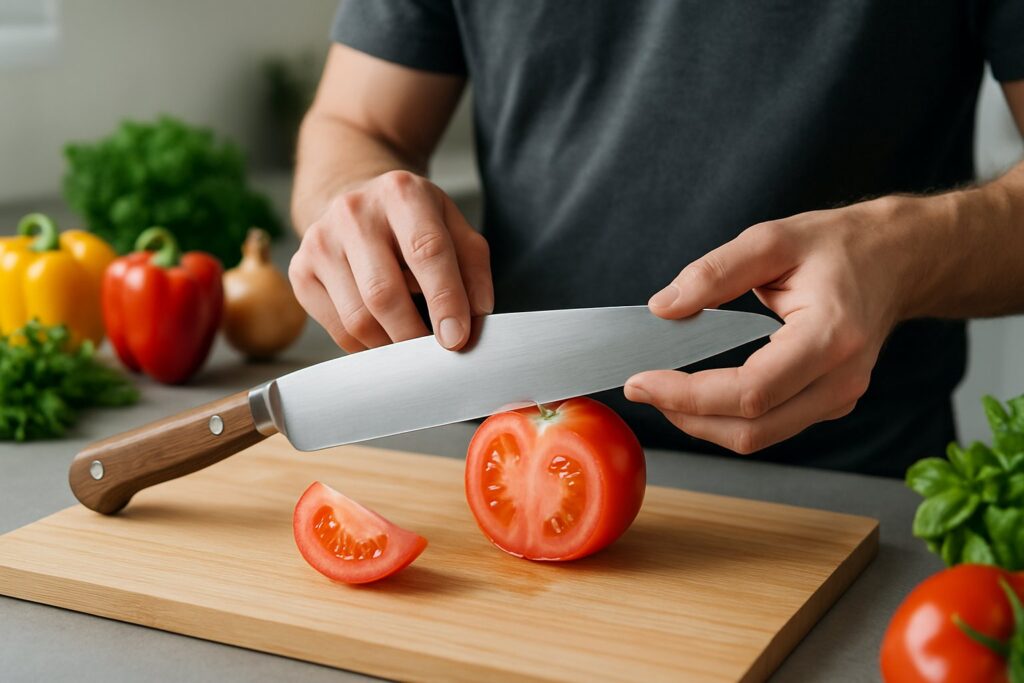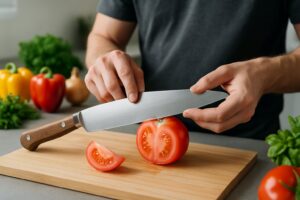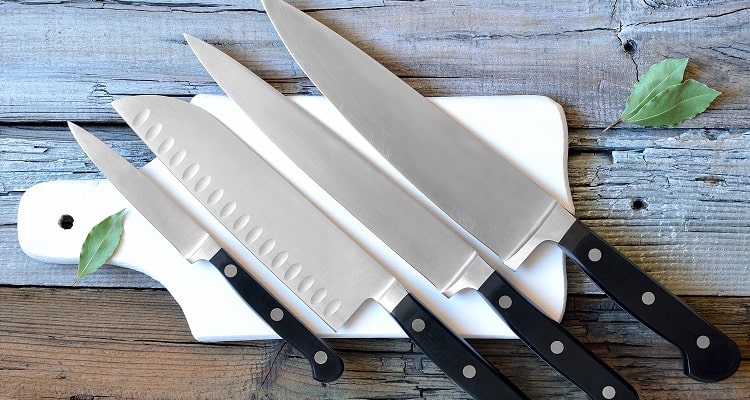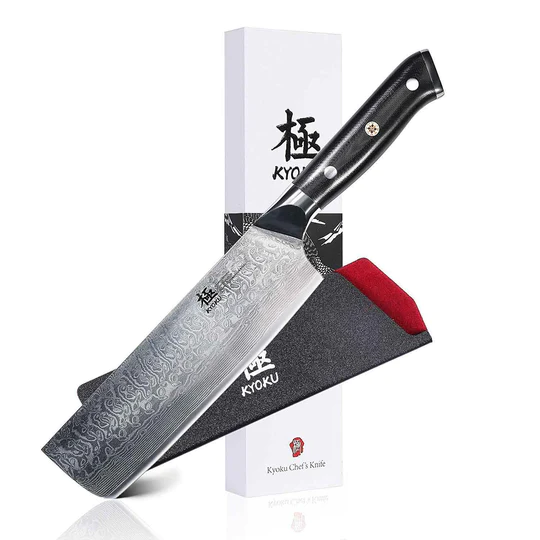


Sharp knives make food preparation faster and more enjoyable. A dull knife is more dangerous because it requires more force to cut, increasing your chances of slipping and injuring yourself. You can easily test if your knife is sharp using these simple methods.
When your blade glides through tomatoes, onions, and other ingredients, you spend less time struggling and more time cooking. Knowing when your knives need sharpening helps you work more safely and efficiently in the kitchen.
You don’t need expensive equipment to check your knife’s edge. Simple household items like paper, tomatoes, or even your fingernail can show whether your blade needs attention. Learning these quick tests will help you keep your knives in top condition.
Testing knife sharpness involves examining the blade’s edge and performing simple cutting tests. A sharp knife cuts cleanly through materials without crushing or tearing them.

Look directly at your knife’s edge under good lighting. Hold the blade at eye level and examine it carefully. A sharp knife has a clean, straight edge without visible nicks or chips. The metal should look uniform along the entire cutting surface.
Check for these signs of a dull knife:
Use the light test method for better visibility. Shine a bright light on the blade edge. Sharp metal doesn’t reflect light because the edge is too thin. If you see light reflecting off certain spots, those areas are dull or damaged. This quick visual check works well when you don’t have materials for other tests.

The paper test is the most reliable way to test knife sharpness at home. You only need your knife and a piece of regular paper.
Hold the paper vertically in one hand. Place your knife at the top edge of the paper. Slice downward through the paper with gentle pressure. A sharp knife cuts cleanly through paper in one smooth motion.
Dull knives will catch on the paper, tear it, or require back-and-forth sawing motions. For an advanced test, try magazine paper. The thin, glossy surface only cuts cleanly with very sharp knives. Fold the magazine paper in half and cut through both layers. Only the sharpest blades can handle this challenge.

The tomato test works perfectly for kitchen knives because you use real food. This test shows how your knife performs during actual cooking.
Choose a ripe tomato with smooth, tight skin. Place it on your cutting board. Rest your knife blade on the tomato skin without pressing down. A sharp knife bites into the skin immediately. Draw the knife through the tomato with minimal downward pressure. Sharp knives create clean slices without crushing the soft interior.

The tomato test mimics real cooking situations. If your knife struggles with tomatoes, it will struggle with other delicate ingredients too.
Signs of a sharp knife include:
Your knife will need sharpening if you find these issues:
The shaving test provides the most accurate measure of knife sharpness. However, this method requires extreme caution and steady hands.
Hold your knife at a shallow angle against your forearm hair. The blade should barely touch your skin. Gently move the knife across the hair without applying pressure. A truly sharp blade cuts arm hair cleanly. The hair should fall away in neat pieces. Dull knives will push the hair aside or require pressure to cut.

Only attempt this test if you have experience handling very sharp knives. One wrong move can cause serious cuts.
Hold a single hair taut between your fingers. Try cutting it with your knife blade. Sharp knives slice through hair instantly. Dull blades will slide along the hair without cutting it.
The thumbnail test works well for checking your kitchen knife without any materials. Place your knife blade at a 90-degree angle against your thumbnail. Apply gentle pressure and try to slide the blade across.
A sharp knife will catch on your nail and feel sticky. A dull blade slides smoothly without catching. Never press hard or slide the blade lengthwise during this test. Only use light pressure perpendicular to the nail surface.
You can also use your chopping board for signs of knife sharpness. Check for deep gouges or scratches after cutting. A properly sharp knife leaves minimal marks on wood or plastic boards.
Excessive board damage means your knife is either too dull and you’re pressing too hard, or the blade needs proper maintenance.
The Brubacher Edge Sharpness Scale (BESS) gives exact sharpness measurements. Lower numbers mean sharper blades:
| BESS Score | Sharpness Level | Performance |
|---|---|---|
| 50-100 | Razor-sharp | Professional grade |
| 100-200 | Very sharp | Premium kitchen knives |
| 200-400 | Working sharp | Good cutting ability |
| 400+ | Dull | Needs sharpening |
Professional testers also use certified materials to measure cutting force. The CATRA testing system provides industry standards for blade performance.
Testing knife sharpness involves several proven methods that work well in most kitchens. Sharp blades have specific visual characteristics and respond predictably to common household tests.
The paper test ranks as one of the most dependable methods for checking sharpness at home. You hold a piece of paper and slice through it with your knife.
The tomato test works well for kitchen knives. Try cutting a thin slice without applying pressure to the tomato.
A visual inspection by looking for light reflections on the edge gives you quick results. Sharp edges don’t reflect light like dull ones do.
Yes, the paper test provides accurate results when done correctly. A sharp knife slices smoothly through paper while a dull blade catches or tears it.
You can use different paper types for this test. Newsprint, office paper, and even tissue paper all work well. Performing a before and after paper test helps you see the difference between sharp and dull blades. The contrast becomes very clear.
A sharp knife edge won’t show light reflections when you hold it up to a light source. Dull blades reflect glare that you can see with your eyes.
The cutting edge should look like a thin, dark line. Any bright spots or reflections mean those areas need sharpening.
Check the entire length of the blade. Some parts might be sharp while others are dull.

The three-finger test means you run your fingertip very lightly across the blade edge. A sharp knife will feel like it wants to bite in or grab your skin.
Test this near the tip of the knife where the blade is thinnest. Move slowly and use very little pressure. This method requires caution and experience. Many people prefer safer testing methods like paper or visual inspection.
A 15-degree angle creates a sharper edge than a 20-degree angle. Most knives work best with sharpening angles between 15 to 20 degrees.
Smaller angles cut better but are more fragile. Larger angles last longer but don’t slice as easily. Japanese knives often use 15-degree angles. German knives typically use 20-degree angles. Choose the angle based on your knife type.
The BESS scale measures cutting force in grams when your knife cuts through test material. Lower numbers mean sharper blades. This system removes guesswork from sharpness testing. You get exact measurements instead of relying on subjective feelings.
Professional sharpeners and knife makers use BESS testing for consistent results. The device costs more than simple paper tests but gives precise data.

Knife Buzz offers independent product reviews on a wide range of knives used in the kitchen, home, and outdoors. We make it easy for you to find the right knife at the best price.